- Home
- Robert J. Sawyer
Illegal Alien Page 3
Illegal Alien Read online
Page 3
But then Frank realized that he hadn’t really established anything. Was Hask the being’s personal name, or the name of its race? Or did the word mean something else? “Hello,” maybe? Frank pointed at Cletus. “Clete,” he said. The alien repeated the word back, and this time Frank was positive that the sound was coming not from the mouth, but the alien’s chest. One of the pockets on its vest contained a small rectangular object; its outline was apparent by the way the fabric was distorted, and the top of the unit was peeking out of the pocket’s flap. The sound had apparently come from it.
The alien pointed at Frank and said his name—this time it did come from the alien’s mouth. He then pointed at Clete and said Clete’s name. Both times the word started softly, but grew louder over the length of the syllable. The alien pointed at the Russian. Frank looked at him, but was damned if he could remember the man’s name.
“Sergei,” said the Russian.
“Sergei,” repeated the device in the alien’s pocket, and then, a moment later, the alien said “Sergei” on its own.
Frank then indicated himself, Clete, and Sergei. “Humans,” he said.
“Wait,” said Sergei. “I object to contact being made in English.”
Frank looked at the man. “This isn’t the time—”
“Certainly is time. You—”
Clete spoke up. “Don’t be a pain. Dr. Nobilio is in charge here, and—”
“Nyet.”
“For heaven’s sake,” said Frank. “We’re getting this all on video. Let’s not squabble.”
Sergei looked angry but didn’t say anything further. Frank turned back to the alien, repeated his pointing at each of the people in turn, then repeated the word, “Humans.”
The alien touched its chest, just as Frank had touched his own moments before. “Tosok.”
“Tosok,” said Frank. “Hask.”
“Humans,” said Hask. “Frank. Clete. Sergei.”
“Now we’re cookin’,” said Clete.
CHAPTER
3
Captain Raintree and the remaining Russians came closer. Dozens of the Kitty Hawk’s crew members had found reasons to come up on the flight deck, and Hask was soon surrounded by an awestruck crowd. Frank and Clete spent hours teaching the alien English nouns and some simple verbs—such as “walk” and “run” and “lift.”
Frank noted more details of Hask’s appearance as time went by. The alien had four mirrored silver lenses—two on the front of his dome-shaped head above the forward arm, and two more in back above the rear arm, an arm that was somewhat less robust and a bit shorter than the one in front. There seemed to be some sort of rust-colored dental plates inside the mouth at the front of the head, but there was a second mouth that lacked such plates in the back of the head. There were also two small orifices at either side of the head, and it seemed that it was through these that the alien was breathing.
As they began building complex phrases it became clear that the Tosok manner of speech was to start each sentence at a low volume and raise it until the end of the sentence was reached. Hask seemed to have trouble following what Frank was saying because the human wasn’t able to emulate this effectively; Hask was only able to parse Frank’s speech if Frank paused for a full second between sentences.
After about an hour a seaman came to within ten feet of Frank, then motioned to catch his eye. Frank said, “Excuse me,” to Hask—not that those were words Hask yet knew, but Frank hoped the alien would understand that they were meant to be polite. He walked over to the seaman. “What is it?”
“Sir, we just got a message from NORAD. They’ve located the alien mothership. It’s in a polar orbit, about two hundred miles up. And, sir, it’s huge.”
The Kitty Hawk set course for New York. The alien came inside the aircraft carrier and allowed Frank and Clete to lead him to the wardroom. To Frank’s astonishment, once they were inside, Hask reached up simultaneously with his front and back hands and let the four mirrored lenses fall into his square palms—he’d been wearing the Tosok equivalent of sunglasses, although Frank couldn’t tell exactly how they’d been held in place. Hask stacked the mirrored lenses into a neat pile, and dropped them into one of the many pockets on his vest.
Hask’s eyes were circular and moist. One of those in front was orange, the other green; one in back was also green, and the fourth was silver-gray. Each had a small vertically oval black pupil in it; each pair seemed to track together.
Hask couldn’t use a chair with a back because of his rear arm. A yeoman got a stool from somewhere, but Hask didn’t seem to have any desire to sit on it.
Clete and Frank continued teaching the alien English; so far, it had shown no interest in reciprocating by teaching the humans its language.
They showed Hask various objects, and spoke their names aloud. The Tosok reached into one of his many pockets and pulled out the small rectangular device that had been helping him with translations. It was the first good look Frank and Clete had got at it. The object was made of something that looked more like ceramic than plastic or metal. There was a cross-shaped arrangement of buttons on it, with six green buttons in each arm of the cross and a blue one in the center, and on its side was a three-holed aperture for some sort of connector. The back of this handheld computer contained a viewscreen, and the computer apparently was also a scanner—Hask could display the interior structure of the objects Frank and Clete showed him, as well as magnify them enormously to study fine details.
The humans also drew pictures on a pad to represent a variety of mathematical and physical concepts. At one point Clete—who was a much better artist than Frank—produced an image of Earth, with an object in polar orbit around it.
“What is that?” asked Frank.
“Ship,” said Hask.
“How many Tosoks?”
“Six.”
“Six plus Hask?”
“Six plus Hask equals seven.”
“Big ship,” said Frank.
“Big ship for big walk,” said Hask.
“Big journey,” corrected Frank.
“Big journey,” repeated Hask.
They didn’t yet have the vocabulary to ask from where the alien had come, but—
“How long journey?” asked Frank.
“Long. Big long.”
Frank went to the porthole and motioned for Hask to follow. Hask placed mirrored lenses over his front eyes again and came over to stand beside Frank. Frank pointed at the sun, then made a circular motion with his arm, hopefully indicating the concept of a day.
“No,” said Hask. It was frustrating. Sometimes Hask grasped what Frank was getting at quickly; other times it took repeated tries to get even a simple concept across. But Hask moved back to the table and took the marker from Clete’s hand—the first direct physical contact between human and Tosok. He then took the drawing of the Earth that Clete had made, lifted it up in his front hand, and pointed at the porthole and the sun beyond with his back hand. Hask then moved the picture of the Earth in a circular motion.
“He’s saying it’s not a question of days, Frankie,” said Clete. “It’s a question of years.”
“How many?” said Frank. “How many years?”
Hask used his front hand to manipulate the buttons on his pocket computer. The unit said something. Hask pushed another button, and this time the computer replied in English. “Two hundred eleven.”
“You’ve been traveling for two hundred and eleven Earth years?” said Frank.
“Yes,” said Hask.
Frank looked at Clete, whose mouth was hanging open in astonishment.
Hask picked up spoken English at a phenomenal rate. One of the things Frank had brought with him was the Random House Unabridged Dictionary, Second Edition, on CD-ROM, which had recorded pronunciations. There was no way to electronically interface Hask’s pocket computer with Frank’s multimedia notebook, but while Frank slept, Hask, who seemed to have no need for sleep, worked his way through the two thousand lin
e drawings included with the CD, and for the ones that made sense to him, he listened to the pronunciations. By the time Frank woke up the next morning, Hask had substantially increased his vocabulary. How much of it was Hask’s own native facility, and how much of it was the doing of his pocket computer, Frank couldn’t say. Hask had explained that the computer could communicate directly to him, apparently by a receiver implanted in one of Hask’s four evenly spaced ear slits (slits that were all but invisible against his gridwork of scales).
Concrete nouns were the easiest for him to learn—Frank had begun calling Hask him rather than it, although they still hadn’t worked out the being’s gender. Synonyms confused Hask, though—the idea of having more than one word to express exactly the same concept was utterly foreign to him. Clete, who was trying to divine whatever he could about Hask’s home world, suggested to Frank that this meant that Tosok culture had always been monolithic, with a single language—most English synonyms were adopted from other languages. Frank used this as another argument to keep on teaching Hask only English, despite the Russians’ continued complaints.
The Kitty Hawk was still two days from New York. Hask could have flown there himself in his lander, or been taken there in one of the aircraft carrier’s planes. But it seemed better to give humanity in general and the United Nations in particular a little time to prepare for the arrival of the alien.
“Is there a hierarchy among the seven Tosoks?” asked Frank. “Hierarchy” might be a big English word, but it was a simple concept that they’d already used repeatedly in discussions of scientific principles, such as the relationship between planets and stars and galaxies.
“Yes.”
“Are you at the top?”
“No. Kelkad is at top.”
“He’s the captain of your ship?”
“Comparable.”
Frank took a drink of water from a glass. He found himself coughing. Clete came over to thump him on the back, but Frank held up a hand and coughed some more. “Sorry,” he said, his eyes red. “It went down the wrong way.” Clete waited a moment to make sure Frank was okay, then went back to his chair.
“Who should speak to our United Nations?” asked Frank, once he’d regained control.
Hask’s topknot was moving in strange patterns; it was apparent he had no idea what to make of the coughing fit. But at last he answered. “Kelkad.”
“Will he come down from ship?”
“I will go get him and others.”
“In your landing craft?”
“Yes.”
Clete piped up from across the room. “Can I go with you?”
Hask didn’t have to turn around; he had eyes in the back of his head. If the question struck him as impertinent, there was no way to tell. “Yes.”
Frank shot an angry look at Clete. If anyone were going to go up, it should be Frank. But they’d agreed to minimize any signs of human conflict—Hask hadn’t understood Sergei’s exchange with Frank out on the flight deck at the time it had occurred, but the alien had doubtless recorded it and played it back now that he had an English vocabulary. They still didn’t know why the Tosoks had come to Earth, but if it was what Frank was hoping—to invite Earth to join the community of intelligent races in this part of the galaxy—then the last thing they wanted to do was emphasize humanity’s inability to get along. It was bad enough that the rendezvous with the alien lander had been performed by a military aircraft carrier and a nuclear sub.
Still…
“Can I go, too?” asked Frank.
“No room,” said Hask. “Lander built for eight; only room for one more.”
“If your ship has a crew of seven, why was the lander built for eight?” asked Frank.
“Was eight. One off.”
“One dead?” asked Frank.
“One dead.”
“Sorry.”
Hask said nothing.
CHAPTER
4
The inside of Hask’s lander was simple and elegant. Frank and Clete had been hoping for a glimpse of some fantastically advanced technology, but clearly almost all aspects of the lander’s operations were automated. There was a single control console with a few cross-shaped keypads similar to the one on Hask’s handheld computer. There were also some recognizable mechanical devices, including cylinders with nozzles that were most likely fire extinguishers.
The most intriguing thing were the Tosok chairs, which were shaped something like tall, sideways saddles. Hask sat on one. As he did so the raised sides rose up to—well, to his “legpits” might be the appropriate term: the hollows beneath where his long legs joined his shoulders. The sides seemed to be spring-loaded. As Hask lowered his weight into the chair, the sides compressed, then snapped into place at just the right height to support him.
There were indeed eight chairs: two in the front row, then two additional rows of three chairs apiece. Clete tried to sit in one of the chairs, but found it excruciating. Hask went over to the wall, which was pale green and waxy in appearance. He touched it, and a hatch popped open. Hask reached in and pulled out a device that looked a bit like a screwdriver, although no part of it seemed to be metallic. He then dropped down to the floor—it was a strange, fluid movement, his long legs folding in three places, and his front arm helping to support his weight. He ended up lying on his front, and his rear arm reached up with the tool held in his four-fingered hand. He did something with it, and the front part of the saddle seemed to come loose. Clete surged forward and grabbed that part of the chair before it toppled onto the Tosok.
Hask then rose to his feet. “Suitable?” he said.
Clete sat down sideways on it, leaning back against the remaining projection from the curving seat. He smiled at Frank. “Ain’t no La-Z-Boy, but it’ll do the trick.”
“When are you going to leave?” Frank said to Hask.
“Whenever Clete is ready.”
“Can I bring my video camera?” asked Clete, indicating an equipment bag sitting on the lander’s floor.
“Yes.”
“All right,” said Clete. “Then let’s go.”
Frank left the spacecraft, and the air-lock door slid shut behind him.
It was three in the afternoon. The sky had been whipped by contrail lashes: dozens of media and government airplanes had flown over the area to get glimpses of the alien ship. The sea was reasonably calm; waves slapped softly against the Kitty Hawk’s hull.
All the arrangements had been made. Hask and Clete would fly up to the mothership, get the rest of the Tosoks, and then land in United Nations Plaza. There was going to be some delay aboard the mothership—Hask lacked the vocabulary to explain exactly why that was—so they would not be returning for about twenty hours.
Frank, meanwhile, would be flown by fighter jet direct from the Kitty Hawk to Washington, where he’d brief the president, who was already miffed that the meeting was taking place at the UN rather than on the White House lawn, as fifties SF films had predicted. They would both then fly to New York; other world leaders were making their way there as well. All in all, Frank was pleased: humanity was handling first contact much better than he’d expected.
The alien lander lifted off the flight deck, its deep green form stark against the pale blue sky. Frank waved as it rose higher and higher. Two F-14s provided an escort—as well as an opportunity to observe the alien ship in flight.
Inside the lander, Clete was getting it all on videotape. No live transmission was possible, unfortunately—the lander was shielded against radio waves, preventing Clete from broadcasting out, and there was no way of using the equipment on hand to interface his camera with the communications system employed by the Tosoks.
Although the four mirrored squares along the pointed bow of the shield-shaped craft did indeed turn out to be windows, Clete found he got a much better view through the wall display inside the ship. The lander rose up, higher and higher; the Atlantic Ocean receded beneath them, and the sky quickly changed from blue to purple to bl
ack. Soon Clete could see the east coast of Central America, and then the west coast of Africa as well. He was literally shaking with excitement—his whole life he’d wanted to go into space, and now it was happening! Adrenaline coursed through his system, and when he caught sight of his own reflection in the wall monitor, he saw that there was a huge grin spread across his face.
The lander continued to rise, and soon it passed over the terminator, into Earth’s nightside. Above, the real stars were rock steady; below, the constellations of city lights twinkled with interference patterns.
Soon the ship was in orbit, and the invisible hand stopped pressing against Clete’s side—he was, after all, sitting side-saddle. He felt himself grow weightless, and his heart pounded even harder with excitement.
And then, there it was—floating majestically in front of them.
The mothership.
It was indeed gigantic. Almost all parts of it were flat black, making it hard to see against the backdrop of space. It seemed to be baton-shaped, with a bulbous habitat module at one end and what appeared to be an engine at the other. That the engine and the living quarters were so far apart suggested to Clete that the power source was nuclear. He’d have to get his colleagues to look over starplates they’d made in the last year or so; in all likelihood, the alien ship had come toward Earth tail first. Most ideas Clete had seen for starflight proposed a continuous acceleration to the halfway point, turning the ship around, then continuously decelerating until the destination was reached. Astronomers might well have inadvertently recorded the fusion exhaust of the braking starship—and from its spectra, something could be gleaned about Tosok technology.
Hask said the Tosok home world had a higher gravity than Earth, but the mothership, of course, was in microgravity now, although during its starflight its constant acceleration would have provided a sensation of normal weight.
Clete was still having trouble maintaining his composure. Flying through space was enough in and of itself to qualify as the greatest thrill of his life, but to have that coupled with actually being in the presence of an extraterrestrial lifeform was almost too much to bear. He’d been grinning so much that his cheeks hurt, and he felt positively giddy.

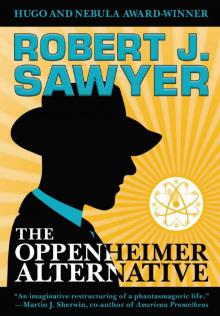 The Oppenheimer Alternative
The Oppenheimer Alternative Factoring Humanity
Factoring Humanity The Shoulders of Giants
The Shoulders of Giants Stream of Consciousness
Stream of Consciousness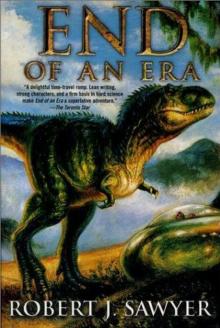 End of an Era
End of an Era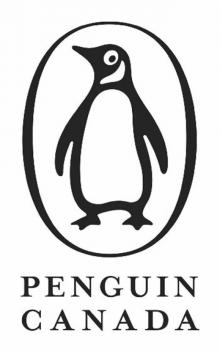 The Terminal Experiment
The Terminal Experiment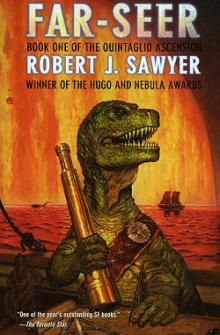 Far-Seer
Far-Seer Mindscan
Mindscan You See But You Do Not Observe
You See But You Do Not Observe Star Light, Star Bright
Star Light, Star Bright Wonder
Wonder Wiping Out
Wiping Out Flashforward
Flashforward Above It All
Above It All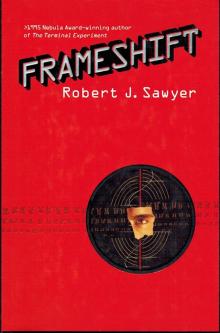 Frameshift
Frameshift The Neanderthal Parallax, Book One - Hominids
The Neanderthal Parallax, Book One - Hominids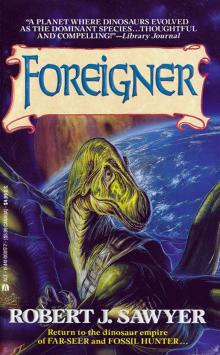 Foreigner
Foreigner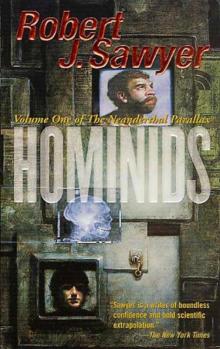 Neanderthal Parallax 1 - Hominids
Neanderthal Parallax 1 - Hominids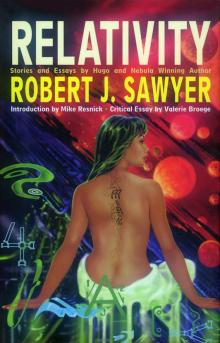 Relativity
Relativity Identity Theft
Identity Theft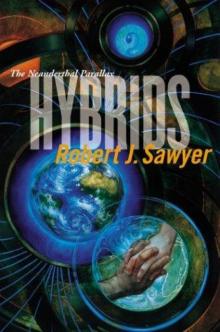 Hybrids np-3
Hybrids np-3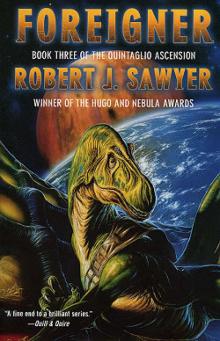 Foreigner qa-3
Foreigner qa-3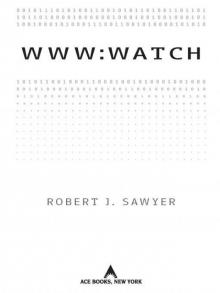 WWW: Watch
WWW: Watch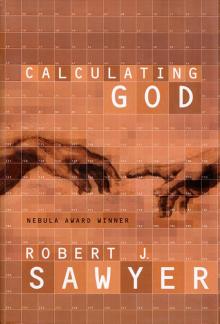 Calculating God
Calculating God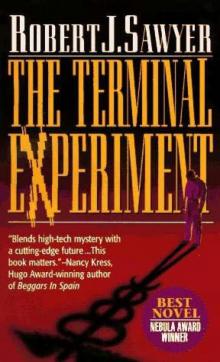 The Terminal Experiment (v5)
The Terminal Experiment (v5) Peking Man
Peking Man The Hand You're Dealt
The Hand You're Dealt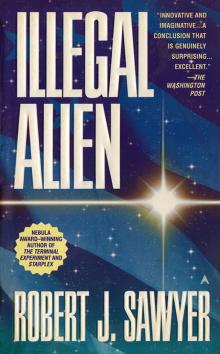 Illegal Alien
Illegal Alien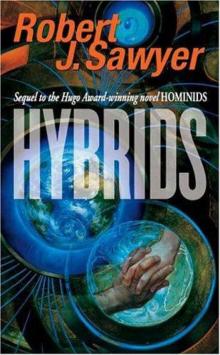 Neanderthal Parallax 3 - Hybrids
Neanderthal Parallax 3 - Hybrids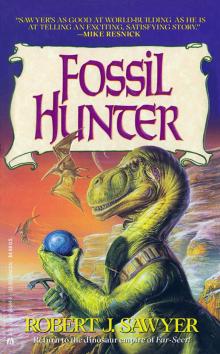 Fossil Hunter
Fossil Hunter WWW: Wonder
WWW: Wonder Iterations
Iterations Red Planet Blues
Red Planet Blues Rollback
Rollback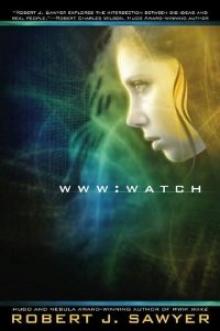 Watch w-2
Watch w-2 Gator
Gator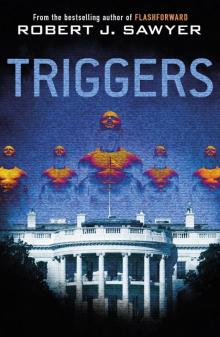 Triggers
Triggers Neanderthal Parallax 2 - Humans
Neanderthal Parallax 2 - Humans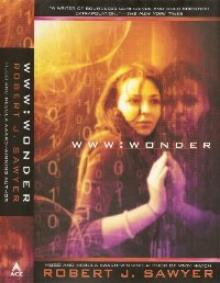 Wonder w-3
Wonder w-3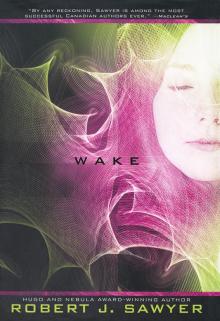 Wake
Wake Just Like Old Times
Just Like Old Times Wake w-1
Wake w-1 Fallen Angel
Fallen Angel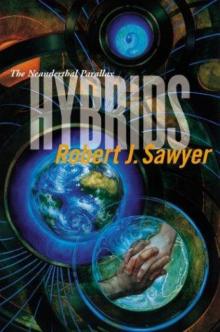 Hybrids
Hybrids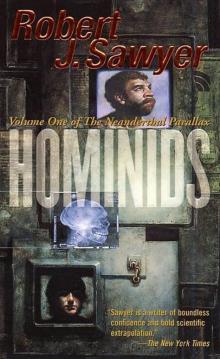 Hominids tnp-1
Hominids tnp-1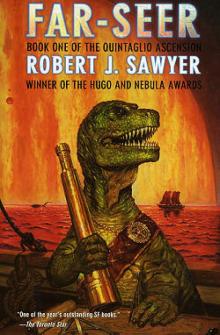 Far-Seer qa-1
Far-Seer qa-1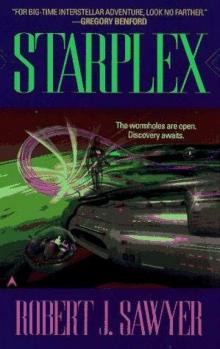 Starplex
Starplex Hominids
Hominids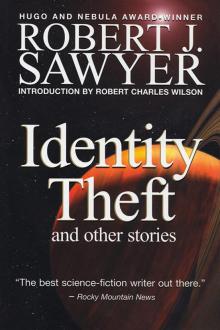 Identity Theft and Other Stories
Identity Theft and Other Stories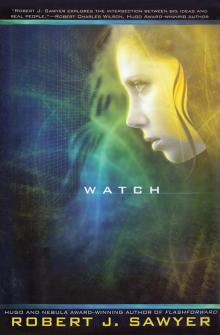 Watch
Watch Golden Fleece
Golden Fleece Quantum Night
Quantum Night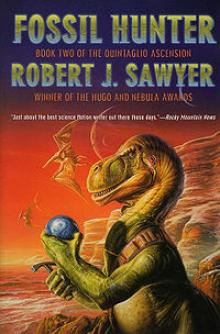 Fossil Hunter qa-2
Fossil Hunter qa-2 Humans np-2
Humans np-2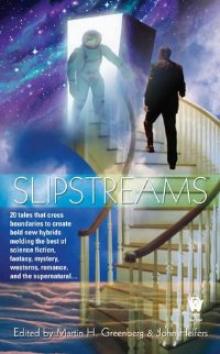 Biding Time
Biding Time